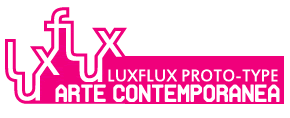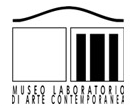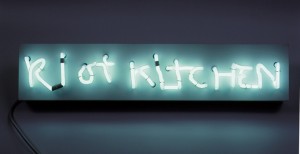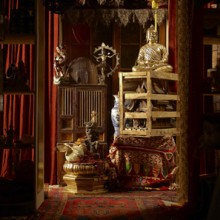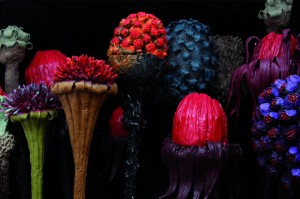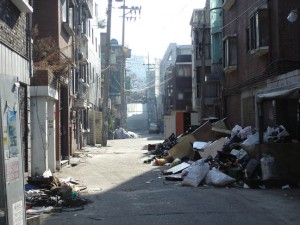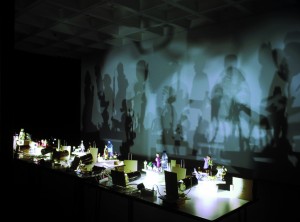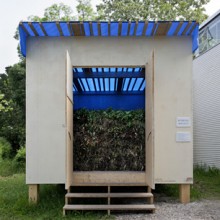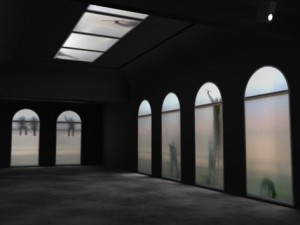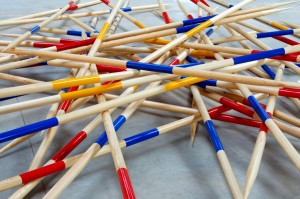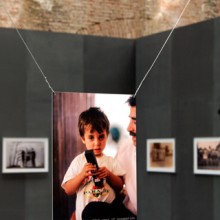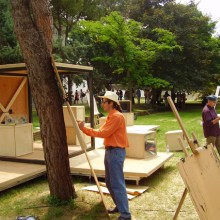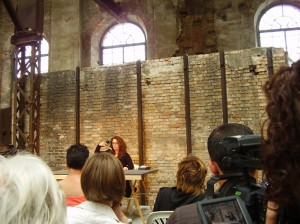In a worried world constantly longing for some form of settlement or its final undoing, the contemporary art presented in Venice appears on first look to be alien to all this, never mind the winds of economic crisis that gently blow all over but appear not to touch in any way the opulent image, a gloss more than its surface, that art has had since the start of the millennium. There has never been, in my memory, a biennial this impetuously luxurious, glamorous and, let us say, wasteful, with the thousands of gadgets that the various pavilions and collateral events have not held back from offering to a public that has been literally overwhelmed by them. In the preview days, we found ourselves physically buried under a mountain of paper and cloth bags covered in various logos; in a truly bizarre game of who could appear most intrusive, visible, spectacularly original and efficient in the promoting and promulgating of their image. A frenzy of vacuous ephemeral cultural consumption that could even cause you to detect a hint to be optimistic and try to cheer up, given the chronic austerity with renewed euphoric faith in a probable future of abundance of which this art seems to have declared itself prophetic announcer.
Under this light, Making Worlds, the title of the main show chosen by director Daniel Birnbaum, would really seem to represent the magic formula for a possible new world of riches and opulence. But this is only an immediate impression, so fleeting that it disappears as soon as one puts aside the gadgetry and tat. Under the shinny surface of the more or less technological gadgets made available to the preview public, selected from, journalists, critics and dealers, the reality of the art is more authentic and altogether different. Even inside of Birnbaum’s own show, crises prevail over the reassuring wasteful framing described. The choice of artists, or more correctly the choice of works and interventions, points towards a comprehensive recontextualization of “making art” on the inside of the numerous possible “worlds” of deterioration where perhaps their ability to exist is the only comfort. Only a few projects are required to confirm this assumption: Rirkrit Tiravanija’s exemplary participation in the realization of a bookshop modelled on the idea of being together, communicating and sharing, much more than a shop where goods are bought and sold, a place of thinking and the interaction between thoughts. The Moscow Poetry Club group wove another occasion for community during their happening that took place at regular intervals reciting poetry whilst attempting to translate the resulting sensations into paint, and urging people to ‘rediscover’ the material sense of things offering bread, real bread, to the public and inviting them to drink water, real water. The installation by the Indian artist Sheela Gowda is made from the matter of life interweaving thick cords of human hair, hair that has been cut for ritual purposes, knotted with giant handles as though to want to imprint a sense of monumental memory of what we are and what is left, in this out of scale installation. The dissipation of memories during a journey as a collector that gathers archives and atlases of that which has been intercepted from life is contained in the installations by Georges Adéagbo, his work is both “poor” yet at the same time full of cultural knowledge. A lighter form of collectionism is the essence of Hans-Peter Feldmann’s complex installations. He collects objects that come from everyday contexts and sublimates them with beams of light and movement in order to construct a theatre of magical lanterns or a Chinese shadow play. The residual traces of time, the wish to store them in the memory in the belief that they are consubstantial to their historic worth pushes Jorge Otero-Pailos to stockpile them, redelivering and sublimating them in the present as indelible identity-making trails. The title is eloquent: Scrape: The Ethics of Dust. Dust, which becomes an integral part of the image of the past. The complex environment created by Nathalia Djuberg is balanced between sensuality, ingenuousness and horror, with figures that live in a capsized fantasy land, where the good is also bad, it is dangerous and twisted but above all it is representative of the unknown. A mixed feeling of voluptuousness and corruption.
And apart from “Making Worlds”? Obviously the national pavilions have also been “made” which this year has seen some extraordinary openings, testimony to this is the unification of the Nordic pavilion with the Danish one to create The collectors with the exceptional critical curation by the duo of artists Michael Elmgreen & Ingar Dragset. The two artists are used to investigations into spheres ever more permeable by both public and private, in this occasion, calling a selection of artists to interpret the theme, they have developed an analysis of collectionism, a practice that connects the private sphere, the public dimension and the autistic obsession with possession. The strong curatorial setup again proves itself to be the most incisive strategy in the Austrian pavilion, Valie Export, who was handed the role as curator, chose to take on Birnbaum’s invite of “Making Worlds” and in particular through the choice of a work like Laubreise by Franziska & Lois Weinberger. This accessible architectural structure was placed outside of the pavilion, erected between the pavilion and the canal, between “culture” and “nature”, a dialogue “between” a want to suggest and an urge for new sensory perception. It is not so much the interstices of reality as what derives from it, its edges, and its residues that instead are the object of the intriguing journey made by Haegue Yang hosted by the Korean pavilion. Memories of places, travels, historical crossings, of what we are when all of these stories meet, is the subject par excellence of the research by Fiona Tan who presents, in the Dutch pavilion, the work Disorient, dedicated to Venice, to its being a city balanced between the orient and occident, to its being an enchanting marriage between juxtaposed memories. Ospiti is the title of the video installation in the Polish pavilion by Krzysztof Wodiczko that examines the world of “forever guests”, immigrants that remain forever “foreign”, always “other”, outside the door of belonging, forever blurred through the glass, as though perennially behind the window cleaning solution that renders existence impalpable and unclear.
The Fear Society in the ‘Pabéllon de la Urgencia’, curated by Jota Castro is one of the collateral events of big impact and energetic vigour. The fear of the everyday need for a jolt that redefines our existence on the earth, our being, constantly paralysed by terror. The persuasive hypothesis is that it is possible to construct a public sociality of the sharing of this fear, from an existential dimension already in existence, from the substance of reality that does not preclude any of the risks, not even the most frightful, as suggested by Tania Bruguera, the Cuban artist who, as though a Russian roulette, during a performance-conference challenged chance, fate and destiny in the search for an antidote to the supine acquiescence towards the inevitable end of everything.
For the rest there remains a final question: how can these crises be reconciled with the glamour, with the diva-like world of contemporary art towards which nobody appears to show disdain? Is it still possible to think of an antidote effective against integration into the system or is this hypothesis just a theoretical formula and therefore not possible?
Translation by Lincoln Dexter
Rirkrit Tiravanija, Riot Kitchen, 2002
Neon, 10 × 60 × 8 cm
Photo: Wolfgang Günzel
Fiona Tan Disorient, 2009
HD installation
colour, 5:1 surround
2 HD-cam safety masters, 2 HD projectors, 2 computers, surround amplifier, surround speakers
edition of 4
Nathalie Djuberg Experimentet (detail), 2009
Installation, clay animation, digital video and mixed media, dimensions variable
Music by Hans Berg
© Nathalie Djurberg
Courtesy: Giò Marconi, Milan, Zach Feuer Gallery, New York
Haegue Yang, Studies for Doubles and Halves – Events with Nameless Neighbors
(Ahyun-dong), 2009
digital photograph
Hans Peter Feldman, Schattenspiel (Shadow Play), 2002-2009
Tecnica mista, dimensioni variabili
Franziska & Lois Weinberger, Laubreise, 2009
Veduta esterna
Krzysztof Wodiczko, Visitors, 2008/2009
Video projection
Courtesy: Profile Foundation
Jota Castro, Shanghai 2, 2009
Installation, 40 Mikado sticks
Each stick 480 cm
Courtesy the artist and Galerie Barbara Thumm, Berlin
Hans Haacke, West Bank, 1994 – 27th Year of Occupation, 2007-2009
2 text panels, each 30x42x5 cm
1 photo panel, 30×21 cm
Courtesy the artist
© Hans Haacke/VG Bild-Kunst
Moscow Poetry Club, 5 giugno 2009, Giardini, Performance
Sheela Gowda, Untitled, 2009
Installazione, capelli, acciaio, dimensioni variabili.
Tania Bruguera, Autosabotage, 5 giugno 2009 Conferenza
